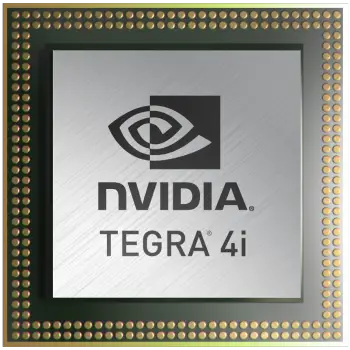
NVIDIA introduces Tegra 4i, the first Tegra processor with integrated LTE
Our friends at NVIDIA have just announced the Tegra 4i, a new chipset that will finally solve NVIDIA’s little LTE problem. Formerly known as Project Grey, Tegra 4i will mark the first ever NVIDIA chipset to come with LTE integrated by default.
It’ll utilize NVIDIA’s own-built i500 modem for the task, a chip that will support 100mbps LTE out of the box but can be software-upgraded to support 150mbps LTE when and if necessary. Tegra 4i is a 28nm quad-core ARM Cortex-A9 R4 chipset (with a fifth low-power companion core) that will be coupled with a 60-core NVIDIA GPU.
The chipset can reach speeds of up to 2.3GHz, and NVIDIA says the chip will be nearly half as big as Qualcomm’s Snapdragon 800, so it should be quite friendly for OEMs to work with when designing the innards of tomorrow’s hardware. NVIDIA is calling it the fastest single-chip configuration out, and that’s true, though we doubt that matters much to the typical user in the grand scheme of things.
Tegra 4 “Wayne” is still NVIDIA’s big powerhouse chipset with its 1.9GHz 4+1 quad-core chipset based on ARM Cortex-A15. Its GPU is 72 core, and has been designated as the perfect SoC for the unofficial “superphone” category, as well as for high-end tablets.
To showcase Tegra 4i, NVIDIA is also announcing Phoenix, a reference platform for OEMs who want to design Tegra 4i smartphones and get them to market quicker. Phoenix isn’t something us mere mortals will appreciate in-hand, but we will eventually appreciate it in the consumer space as it will help OEMs deliver great smartphones sooner than we can toss our wallets at our displays.
Phoenix will house a 5-inch 1080p display and all the bells and whistles you typically find in today’s smartphones. The company will be in Barcelona for Mobile World Congress showing its new toys off, and you can bet we’ll be making a stop by its booth to see for ourselves.Be sure to read more juicy bits by reading on for full press details.
NVIDIA Introduces Its First Integrated Tegra LTE Processor
Tegra 4i Delivers Highest Performance of Any Single-Chip Smartphone ProcessorSANTA CLARA, Calif.—February 19, 2013— NVIDIA today introduced its first fully integrated
4G LTE mobile processor, the NVIDIA® Tegra® 4i, which is significantly faster yet half the size
of its nearest competitor.
Previously codenamed “Project Grey,” the Tegra 4i processor features 60 custom NVIDIA
GPU cores; a quad-core CPU based on ARM’s newest and most efficient core— the R4
Cortex-A9 CPU— plus a fifth battery saver core; and a version of the NVIDIA i500 LTE
modem optimized for integration. The result: an extremely power efficient, compact, high-
performance mobile processor that enables smartphone performance and capability
previously available only in expensive super phones.
“NVIDIA is delivering for the first time a single, integrated processor that powers all the
major functions of a smartphone,” said Phil Carmack, senior vice president of the Mobile
business at NVIDIA. “Tegra 4i phones will provide amazing computing power, world-class
phone capabilities, and exceptionally long battery life.”
Tegra 4i’s new 2.3 GHz CPU was jointly designed by NVIDIA and ARM, and is the most
efficient, highest performance CPU core on the market.
“Tegra 4i is the very latest SoC solution based on the ARM Cortex-A9 processor and
demonstrates the ability of ARM and our partners to continue to push the performance of
technology and create exciting user experiences,” says Tom Cronk, executive vice president
and general manager, processor division, ARM. “ARM and NVIDIA worked closely to further
optimize the Cortex-A9 processor to drive performance and efficiency in areas such as streaming and responsiveness. This is an example of the collaboration and innovation that enables ARM technology-based solutions to be market drivers through multiple generations
of SoC solutions.”Utilizing the same architecture as Tegra 4’s GPU, Tegra 4i features five times the number of
GPU cores of Tegra 3 for high-quality, console-quality gaming experiences and full 1080p HD
displays. It also integrates an optimized version of the NVIDIA i500 software-defined radio
modem which provides LTE capabilities, and makes networking upgradability and scalability
fast and easy.
”NVIDIA’s Tegra 4i appears to outperform the leading integrated LTE chip significantly, and
also benefits from an integrated ‘soft-modem’ that can be re-programmed over-the-air to
support new frequencies and air interfaces – something other modem vendors can only
dream of,” said Stuart Robinson, director, Handset Component Technologies Program at
Strategy Analytics.”
Tegra 4i mobile processor’s camera capabilities include the NVIDIA Chimera™
Computational Photography Architecture recently announced in Tegra 4. This delivers many
advanced features, including the world’s first always-on high dynamic range (HDR)
capabilities, first tap to track functionality and first panoramic photos with HDR.
NVIDIA also introduced its “Phoenix” reference smartphone platform for the Tegra 4i
processor to demonstrate its unique mobile technologies. Phoenix is a blueprint that phone
makers can reference in designing and building future Tegra 4i smartphones to help get
them to market quicker.
The Tegra 4i mobile processor will be demonstrated in the NVIDIA booth in Hall 7, Stand
#C110, at the 2013 Mobile World Congress show in Barcelona, Spain, on Feb. 25-28.About NVIDIA
NVIDIA (NASDAQ: NVDA) awakened the world to computer graphics when it invented the
GPU in 1999. Today, its processors power a broad range of products from smartphones to
supercomputers. NVIDIA’s mobile processors are used in cell phones, tablets and auto
infotainment systems. PC gamers rely on GPUs to enjoy spectacularly immersive worlds.
Professionals use them to create 3D graphics and visual effects in movies and to design
everything from golf clubs to jumbo jets. And researchers utilize GPUs to advance the
frontiers of science with high performance computing. The company has more than 5,000
patents issued, allowed or filed, including ones covering ideas essential to modern
computing. For more information, see www.nvidia.com.